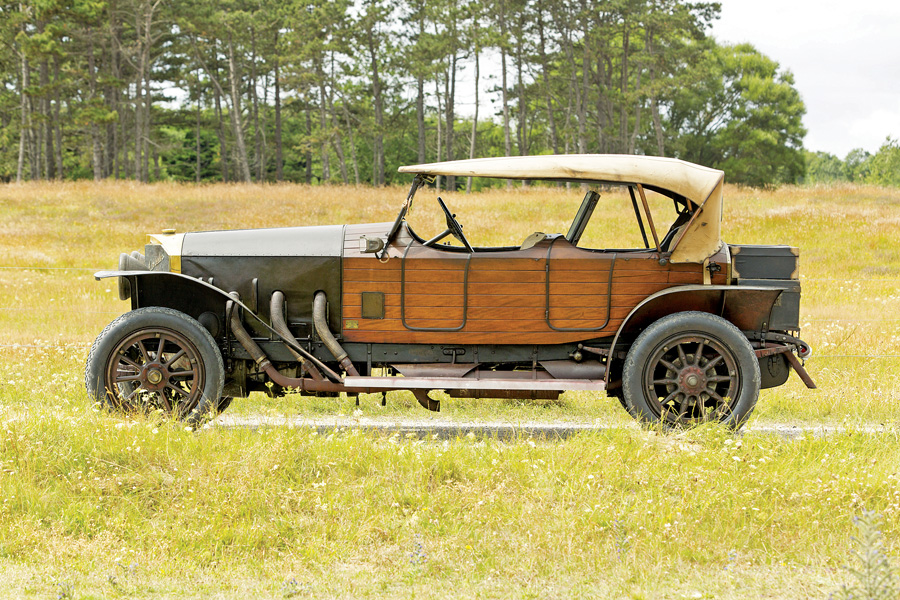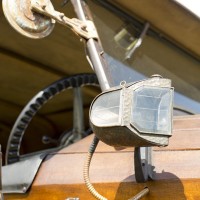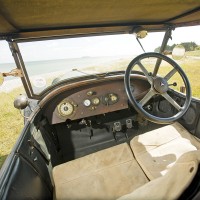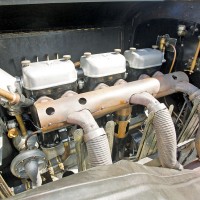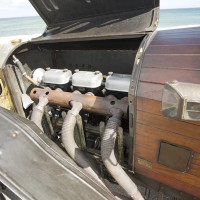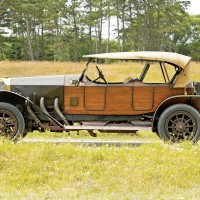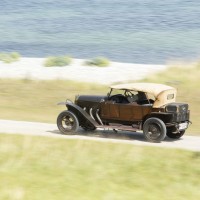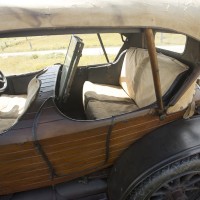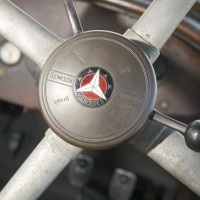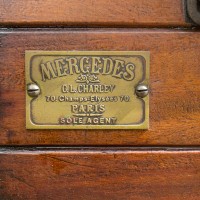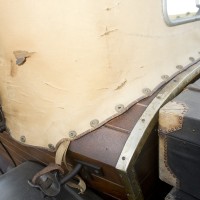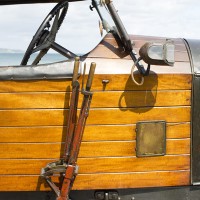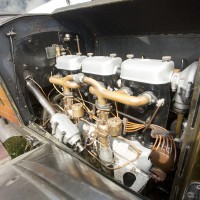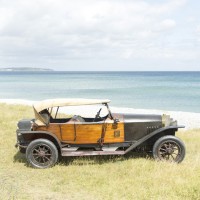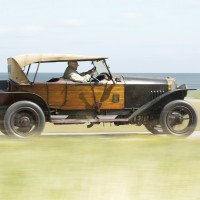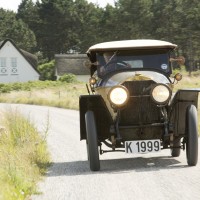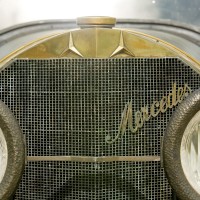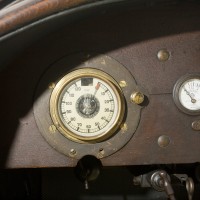Readied in 1914 to replace the 4-cylinder 37/90, for all intents and purposes, the Mercedes 28/95 did not reach production until after World War I. By the time it did reach its customers, the big 7,280-cc, 90-bhp overhead-camshaft 6-cylinder engine had been fitted with a cover to enclose the previously exposed shaft-and-bevel gear-driven valve-gear.
Two Zenith updraft carburetors and individual intake passages to each cylinder ensured exceptional breathing for the period. The large six was closely related to the Daimler DF80 aircraft engine and mounted in a chassis that was quite stiff for the period. Six forged-steel cylinders, set inline in pairs and wrapped with pressed steel water jackets, provided substantially more strength than conventional cast cylinders. The water pump was driven by a bevel gear connected to the vertical gear drive for the valve train.
The 28/95 was the first model to feature the soon-to-become-classic vee-shaped grille on a Mercedes, as well as the exhaust pipes wrapped in flexible metal hoses. The beefy frame consisted of two U-shaped beams connected by cross members.
Later, a short-wheelbase version became available, as did a supercharged engine. In this way, the 28/95 was the first of Mercedes’ sporting 6-cylinder cars and pointed the way down the path that eventually resulted in the much vaunted S, SS, SSK and SSKL models.
The archives of Mercedes-Benz Classic state that the file for Kommissionsnummer 16835 indicates that Mercedes 28/95 chassis number 15979 was correctly fitted with engine 22781. The destination for the chassis was New York, and the date of delivery was September 30, 1920. The archive further lists that in 1921, a Sindelfingen-built bodyshell of a four-seater open tourer was delivered to New York for this chassis. According to a 2004 article by David Newhardt, the Daimler-Motoren-Gesellschaft built a total of 5,985 cars in 1914, which made the company one of the world’s largest car makers. The article goes on to state that commission number 16835 was ordered in July 1914, that the car was intended for shipping to Paris and that the factory fitted the chassis with a handsome wood-planked body.
It should be noted that the wooden body now mounted on 15979 carries an extremely rare plaque indicating “C.L. Charley, 70 Champs Élyseés, Sole Agent.” The sales network in France of the Daimler-Motoren-Gesellschaft had been in turmoil from 1904 to late 1910. During that time, a certain Charley Lehman, using the moniker C.L. Charley, had been the general agent for France, Belgium and America for the Daimler-Motoren-Gesellschaft. He operated a rather stupendous showroom at number 70 Champs-Élysées called the Mercedes Palace.
The C.L. Charley plaque dates the original body to the 1907–10 period, and it could possibly have been constructed to a C.L. Charley order by Jacques Saoutchik, who was a carpenter by trade.
According to the auction description for 15979 when it was sold in 1993 as part of the estate of Ben Paul Moser, the car was ordered in 1914 by Mercedes Paris, but the order was canceled due to the outbreak of World War I. Then in 1917, a Berlin banker ordered the car but canceled it for reasons unknown. On December 15, 1919, Mr. Alfred Bourne of the Mercedes Repair Company, 218 East 54th Street, New York City, ordered the car, and it was shipped as a chassis one year later. In essence, there is some difficulty in determining an exact date of manufacture for this car.
Perhaps the discrepancy or confusion in dates of manufacture can be explained by the repeated order cancellations or interruptions at the works because of the war. Commodore Moore of the New York Yacht Club bought the car from Alfred Bourne, after which the car was then owned by a succession of sportsmen, and in 1932 was bought by Kirk Gibson, who drove it for a year as a commuter car between Cape Cod and his classes at Harvard University.
In the 1940s, the car became part of the George Waterman collection in Rhode Island. Waterman kept 15979 until the 1960s, when it went to Richard Paine of Seal Harbor, ME. Sometime later the car was acquired by Tom Barrett of Barrett-Jackson auction fame, who sold it to Santa Barbara antique car sleuth and sometime dealer Ben Paul Moser. Moser kept 15979 until his death, whereupon it was purchased by Richie Clyne at the 1993 auction. Clyne in turn sold the Mercedes to antique car collector and hotelier Bill Evans of San Diego.
Evans recognized that the chassis, engine and body of 15979 remained original and unrestored. When Evans first got the car, he soaked the wooden body in linseed oil for three years, while cleaning up the rest. It received a new set of tires, while the original top and upholstery were covered by protective canvas. A close examination of the wood at the rear reveals that the body was likely a French boattail-type skiff originally, and that the pointed rear has been abbreviated at some point in order to create space for the antique luggage set. It is believed that at some point the original D.F. 80 engine, or parts of it, was replaced with a similar unit, and the original carburetors replaced with Zenith Detroits. This information stems from a note in the 1993 auction catalog; however, the engine tag carrying number 22781 affixed to the engine today appears to be the original one.
Bill Evans used his powerful Mercedes, driving it about 1,000 miles a year, and he likened the brutish car to being something of an E63 AMG of its day. In August of 2003, Evans showed 15979 in the preservation class at the Pebble Beach Concours d’Elegance. He drove the car much of the way to and from his San Diego home. At Pebble, it won the FIVA Award for most original car.
Henrik Frederiksen subsequently acquired 15979, and it was refurbished by the noted Mercedes specialist Reifen-Wagner, which included a rebuild of the magneto. The engine originally required hand-cranking, but an electric starter has now been fitted. A folder comes with the car with numerous photographs of the engine renovation work that has been carried out. In addition, a photocopy of the extremely scarce 28/95 instruction manual is included in the files.
While it has not been possible to precisely determine when the chassis and the lovely wooden body were united, both are highly original, and today this 28/95 provides a unique look backward at how the Daimler-Motoren-Gesellschaft built luxury cars close to 100 years ago.
SCM Analysis
Detailing
| Years Produced: | 1914 to 1925 |
| Number Produced: | 590 (25 Series 1 cars between 1914 and 1915 and 565 Series 2 cars between 1920 and 1924) |
| Original List Price: | N/A |
| SCM Valuation: | $650,000–$850,000 |
| Tune Up Cost: | $2,500 |
| Distributor Caps: | $2,500 |
| Club Info: | Mercedes-Benz Club of America |
| Website: | http://www.mbca.org |
| Alternatives: | 1922–25 Bentley 3 Litre, 1927–30 Mercedes-Benz S tourer, 1907–25 Rolls-Royce Silver Ghost |
| Investment Grade: | A |
This car, Lot 28, sold for $1,401,029, including buyer’s premium, at Bonhams’ Frederiksen Auction in Ebeltoft, Denmark, on September 26, 2015.
When SCM executive editor Chester Allen contacted me to do a write-up on this car, I almost passed. Admittedly, except for hot rods, I’m not really a pre-war guy, but as I read Bonhams’ write-up, I was intrigued.
Ninety horsepower was some serious oomph in 1914. Based on a 7.3-liter aircraft engine with a single overhead cam, twin Zenith updraft carbs, and an alloy crankcase, this was the leading edge of automotive technology before the war. As with most wars, there were rapid advances in the late teens. Necessity is, after all, the mother of invention.
Going over the auction description, I was astounded to find out the car had initially been ordered in 1914, then canceled and reordered a couple of more times before finally being completed in 1920. As with a lot of cars of this era, a driving chassis was delivered to a coachbuilder to have a body designed to meet the customer’s needs. It was not unusual to have two bodies built: one for summer, and one for winter use.
The designation 28/95 was used to denote two things: 28 was the taxable horsepower and 95 was the actual horsepower. This model was the grandfather of what was to become the wildly successful SSK and SSKL racers.
Never restored
The fact that this grand motorcar still exists almost unchanged 100 years later is due in no small part to the men who cared for her. It’s like reading the Who’s Who list of the classic car world, starting with George Waterman in the 1940s. From there it goes through the loving hands of Richard Paine, Tom Barrett, Ben Paul Moser, Richie Clyne and Bill Evans. To a man, all resisted the temptation to restore her.
Now, I have got nothing against restored cars, but there’s just something so special about a car that’s 100 years old, and is still on the road. All it took was just regular maintenance and driving. How cool is that?
Dripping history — and value
Although I stated that I am not a pre-war car guy, my favorite class now at Pebble Beach is the pre-war preservation class. Crazed paint, yellowed glass and distressed leather all suck me in. I love to think of where these cars have been — and how they have escaped the scrap yard or the restorer’s touch. The stories they could tell.
Given the condition and the ownership history, this is a bona fide Blue Chip investment.
The buyer added his or her name to a list of the hobby’s most knowledgeable and considerate custodians. It’s like having the car fully vetted for you.
If this Mercedes were a pre-war Bentley in this condition, it would easily be twice the price. For that reason — and for what this car is and represents, I’d call this extremely well bought. ♦
(Introductory description courtesy of Bonhams.)
